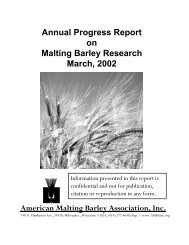Annual Progress Report on Malting Barley Research March, 2007
Annual Progress Report on Malting Barley Research March, 2007
Annual Progress Report on Malting Barley Research March, 2007
You also want an ePaper? Increase the reach of your titles
YUMPU automatically turns print PDFs into web optimized ePapers that Google loves.
A sec<strong>on</strong>d aim of this research was to study the leaf rust resistance gene Rph13 in the<br />
barley line “PI531849”, to identify putative resistance related markers, and to map the gene<br />
using molecular markers. Crosses were made between the resistant parent “PI 531849”<br />
c<strong>on</strong>taining resistance gene Rph13 and “Bowman”, a cultivar susceptible to leaf rust.<br />
Inheritance studies were performed by screening F2 progeny and F2:3 families against<br />
pathotype “Race 8” of P. hordei to determine the leaf rust resistance genes in “PI 531849”.<br />
Data showed a single resistance gene, Rph13, acted in a dominant manner. Using<br />
diversity array technology (DArT) and simple sequence repeat markers (SSRs), Rph13 was<br />
mapped to chromosome 3H. The SSR marker EBmac0541 was mapped 0.5 cM distal to<br />
Rph13 and may be useful for MAS if further flanking markers can be identified.<br />
A selecti<strong>on</strong> of races of P. hordei were used in the greenhouse to screen for resistance in a<br />
collecti<strong>on</strong> of 82 barley lines from the breeding program at NDSU. Resistance was identified<br />
in barley line “C2-02-134-2-2” which had a different phenotype from the resistance gene,<br />
Rph15 which had already been shown to exist in that line. In the F2 generati<strong>on</strong> of a cross<br />
between C2-02-134-2-2 and ZA47, the Rph15 phenotype (00;) was separated from the<br />
sec<strong>on</strong>d resistance gene phenotype (0;12-). A cross was then made between barley line<br />
“4A” which c<strong>on</strong>tained <strong>on</strong>ly the sec<strong>on</strong>d gene and “Bowman”, and the progeny were use in an<br />
inheritance study and for gene mapping by DArT. The new resistance was shown to be due<br />
to a single dominant gene. The gene was mapped <strong>on</strong>to barley chromosome 7H. When<br />
inoculated with a set of P. hordei isolates the gene showed different phenotypic reacti<strong>on</strong>s<br />
from that of Rph3 and Rph19 already known to be <strong>on</strong> chromosome 7H, which is some<br />
evidence that it is a new gene.<br />
We are very happy with the progress in this project as we achieved significantly more in<br />
than was proposed in the AMBA project proposal.<br />
4. C<strong>on</strong>duct detailed field surveys to determine the incidence and severity of barley<br />
diseases in Western North Dakota. After 4 years of funding the SBARE <strong>Malting</strong> <strong>Barley</strong><br />
for Western North Dakota project has been incorporated into the ND Ag Experiment Stati<strong>on</strong><br />
Budget. I now apply annually to the Experiment Stati<strong>on</strong> for the $12,000 to employ crop<br />
scouts and their travel to c<strong>on</strong>tinue the survey. The m<strong>on</strong>ey allocated does not fully cover<br />
the cost and a small amount has come from AMBA funds to support this effort. In 2006 I<br />
again lobbied successfully for ND Ag Experiment Stati<strong>on</strong> funds to c<strong>on</strong>tinue the service, but<br />
the intenti<strong>on</strong> is to redirect the SBARE <strong>Malting</strong> <strong>Barley</strong> for Western North Dakota funds<br />
toward agr<strong>on</strong>omic research and it is likely that this service will be disc<strong>on</strong>tinued in future<br />
years.<br />
To achieve this aim I have developed collaborati<strong>on</strong>s with Dr Marcia McMullen (small grains<br />
pathology extensi<strong>on</strong> Fargo), Dr Janet Knodel (plant protecti<strong>on</strong>/entomology extensi<strong>on</strong><br />
Fargo) and Mr. Roger Ashley (small grains agr<strong>on</strong>omy Dickins<strong>on</strong>) to sample barley fields<br />
across the state for leaf, stem head and root diseases with an emphasis <strong>on</strong> Western North<br />
Dakota. Prior to the initiati<strong>on</strong> of this survey <strong>on</strong>ly about 60 barley fields were sampled<br />
annually in North Dakota with patchy distributi<strong>on</strong>s in the West of the state. Disease survey<br />
staff was employed between June and August 2006 to systematically sample barley fields<br />
for seedling and mature plant diseases as well as for insects. Due to the severe drought in<br />
64
















